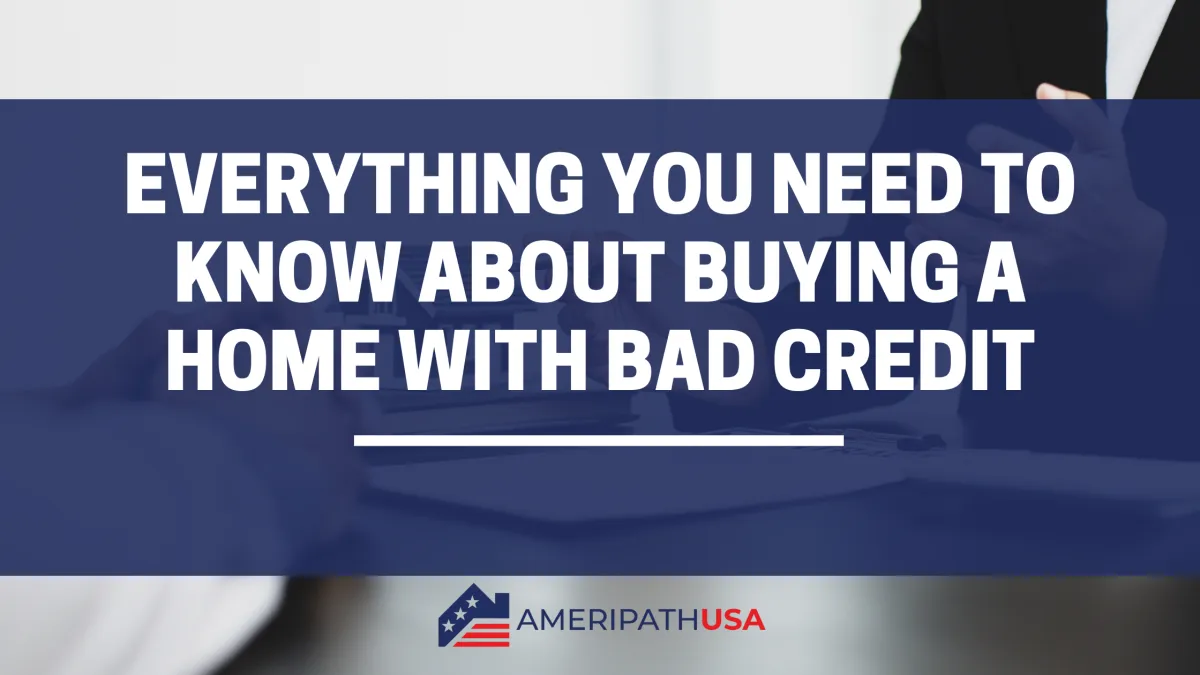
Everything You Need to Know About Buying a Home with Bad Credit
Hearing the words “bad credit” can feel like a dead end, especially when it comes to buying a home. Maybe you’ve missed a few payments in the past. Maybe life threw you a curveball, and your credit score took a hit. Or maybe you’re working hard to rebuild, but you keep running into the same wall: the bank says “no.”
If that sounds familiar, I want you to hear this loud and clear:
Bad credit doesn’t have to stop you from becoming a homeowner.
At AmeriPath Homes, we’ve worked with countless buyers who didn’t have perfect credit—and they still got the keys to their own homes. You don’t have to be a “perfect” borrower to own a home. You just need the right approach.
In this post, I’m breaking down everything you need to know about buying a home with bad credit. No jargon, no fluff—just honest, real talk.
First—What Counts as “Bad” Credit?
When lenders talk about credit, they’re usually referring to your credit score. A score under 580 is often labeled “poor,” while scores between 580-669 are considered “fair.” Anything above 670 is “good” or “excellent.”
But here’s the thing: a credit score doesn’t tell your whole story.
Maybe you had medical bills. Maybe a divorce or job loss knocked you down. Maybe you’re self-employed, and your income looks different on paper.
Banks often look at just the number, not the person behind it. That’s why so many people with “bad credit” get turned away, even when they can actually afford a home.
Can You Buy a Home with Bad Credit?
Short answer: yes. But it’s harder with a traditional bank.
Most banks have strict credit requirements. If your score isn’t high enough, they’ll either deny your application or offer a loan with sky-high interest rates.
That’s why many buyers with bad credit turn to alternative financing options—like seller financing.
With seller financing, the seller acts as the lender. Instead of borrowing from a bank, you make payments directly to the seller. This makes it possible to bypass the strict credit rules banks follow.
At AmeriPath Homes, this is what we specialize in: giving buyers another way forward when banks won’t.
What You’ll Need Instead of Good Credit
If you’re buying a home with bad credit, lenders (or sellers) will usually focus on a few key things:
✅ A Down Payment. The bigger your down payment, the stronger your position. At AmeriPath Homes, down payments typically start around $5,000, but it depends on the home.
✅ Proof of Income. Even if your credit isn’t great, being able to show you have stable income (even self-employed income!) helps. We’re not looking for W2s and perfect paperwork—we just want to see you can afford the payments.
✅ A Track Record of Responsibility. Maybe your credit score is low because of things in the past. If you’ve been keeping up with rent, utilities, or other payments recently, that’s something we take into account.
In other words: bad credit isn’t the end of the story. It’s just one piece of the puzzle.
Step-by-Step: How to Buy a Home with Bad Credit
Step 1: Find a Seller Who Offers Seller Financing
Not every seller is willing to finance a buyer. You’ll need to look for homes being sold with seller financing included. That’s where we come in—AmeriPath Homes has homes ready for buyers just like you.
Step 2: Review the Terms Upfront
We’ll be crystal clear about the price of the home, the down payment, the monthly payment, and any interest. No surprises. No hidden fees. We want you to feel empowered, not overwhelmed.
Step 3: Provide Your Down Payment & Income Info
We’ll ask for proof of income and the down payment to get started. Don’t worry—we’re used to working with gig workers, entrepreneurs, and people with non-traditional income.
Step 4: Move In & Start Building Equity
Once you’re approved and your agreement is signed, you get the keys! You’ll make monthly payments directly to us, just like you would to a bank—but without the red tape. And every payment you make builds equity in your home.
Step 5: Consider Refinancing in the Future
A lot of our buyers use seller financing as a bridge. Down the road, once you’ve built equity and your credit improves, you may decide to refinance with a traditional lender for better terms. But the key difference is—you’re already a homeowner.
What Are the Pros & Cons?
Buying a home with bad credit through seller financing isn’t perfect for everyone, but here’s a quick breakdown:
Pros:
✔️ Easier approval process
✔️ No strict credit requirements
✔️ Faster closing
✔️ You can start owning right away
Cons:
➖ You may pay a higher interest rate than a bank’s lowest rates
➖ Down payment requirements can be higher than an FHA loan
But for many buyers, the trade-offs are worth it. It’s the difference between renting forever or finally owning a home.
Final Thoughts
Here’s what I want you to take away from this: Bad credit doesn’t have to define your future.
You CAN own a home. It might take a different path. It might take working with a company like AmeriPath Homes that sees the whole person—not just a score. But it’s possible.
If you’re ready to explore your options, or if you just want to talk it through, we’re here. We’re not going to judge you or make you jump through hoops. We’re here to help you take that first step toward ownership.
Because everyone deserves a place to call home—even if the banks say no.
